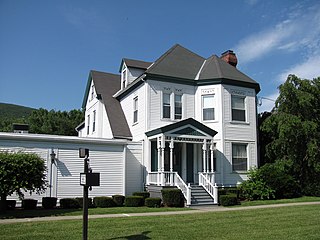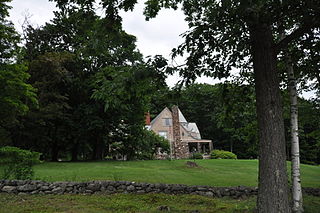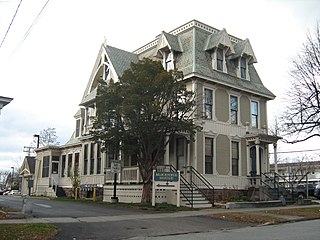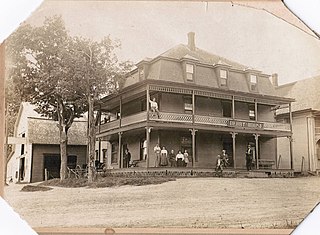
The Sykes House is a historic house located at 521 West Main Street in North Adams, Massachusetts. It was built in 1890, and is a prominent local example of Queen Anne architecture. It was listed on the National Register of Historic Places in 1985.

The United Methodist Church of Isle La Motte, also previously known as the Methodist Episcopal Church of Isle La Motte and known locally as the Old Stone Church, is a historic church in Isle La Motte, Vermont. Built in 1843 by a prominent local Scottish stonemason, its basement was used until 1892 for town meetings and a school, while the upstairs was used for religious services. It was listed on the National Register of Historic Places in 2001.

The Benjamin Wiley House is a historic house on Fish Street in a rural part of northern Fryeburg, Maine. Its oldest part dating to 1772, it is one of oldest buildings in the town. The portion, now the ell of a larger Federal-style structure built 1790–92, was built by Benjamin Wiley, one of Fryeburg's early settlers. The house, which demonstrates the organic growth of old houses in rural Maine, was listed on the National Register of Historic Places in 1980.

The Asahel Kidder House, is an historic house at 1108 South Main Street in Fair Haven, Vermont. Built about 1843, by the efforts of a prosperous local farmer, it is a remarkably sophisticated expression of Greek Revival architecture for a rural setting. It was listed on the National Register of Historic Places in 1997.

The Augustus and Laura Blaisdell House is a historic house at 517 Depot Street in Chester, Vermont. Built in 1868 for a local businessman, it is a fine local example of transitional Greek Revival-Italianate architecture. It has historically served both commercial and residential functions, and now contains apartments. It was listed on the National Register of Historic Places in 2014.

The Jedediah Strong II House is a historic house at the junction of Quechee Main Street and Dewey's Mill Road in Hartford, Vermont. Built in 1815 by a local mill owner, it is a fine local example of a high-style Federal period brick house. It was listed on the National Register of Historic Places in 1974. It now houses professional offices.

Wildwood Hall is a historic house on Moore's Hill Road in Newbury, Vermont. Also known locally as The Castle, it is a distinctive example of Shingle style architecture, designed as a country house by William M. Butterfield and completed in 1895. It was listed on the National Register of Historic Places in 1978.

The Grand Isle County Courthouse is located at 3677 United States Route 2 in the center of North Hero, the county seat of Grand Isle County, Vermont. Built in 1824, it is one of the oldest surviving courthouses in the state, and the only surviving one built out of stone. It was listed on the National Register of Historic Places in 1996.

The Martin L. Kelsey House is a historic house at 43 Elmwood Avenue in Burlington, Vermont. Built in 1879 for a local merchant, it is a distinctive and architecturally varied house, with elements of the Second Empire, Queen Anne, and Stick styles on display. It was listed on the National Register of Historic Places in 1983, and now forms part of a senior housing complex.

The Normand House is a historic residential property at 163-65 Intervale Avenue in Burlington, Vermont. Built in 1869 as a single-family and enlarged into three units in 1890, it is a well-preserved example of period worker housing. It was listed on the National Register of Historic Places in 2008.

The Dr. B.J. Kendall Company is a historic industrial facility at 228 North Main Street in the Enosburg Falls village of Enosburgh, Vermont. Built in 1880, it was for many years the site where "Kendall's Spavin Cure", a treatment for a horse ailment, was manufactured and marketed. This business was one of the town's economic successes, its owners contributing significantly to its architectural heritage. The building was listed on the National Register of Historic Places in 1993; as of 2016, it is standing vacant.

The Old Red Mill and Mill House are a historic 19th-century mill building and residence on Red Mill Drive in Jericho, Vermont. The mill was built in 1856 and enlarged later in the 19th century, accommodating then state-of-the art grain rollers, and was a prominent local business. The house was built in 1859, and is a good local example of Gothic Revival architecture. The mill is now a museum property of the local Jericho Historical Society. The mill building was listed on the National Register of Historic Places in 1972; the listing was expanded to include the house in 1976.

The South Hero Inn is a historic commercial building at 301 United States Route 2 in the center of South Hero, Vermont. Built in 1829, it is a prominent local example of a stone building with Federal and Greek Revival features, and served as a traveler accommodation until the early 1970s. It was listed on the National Register of Historic Places in 1975. It now houses a branch of Community Bank, N.A.

The Richwood Estate is a historic house on United States Route 7 in southern Swanton, Vermont. It was built in 1871 for C.W. Rich, owner of a local lime processing company, and is a distinctive example of Second Empire architecture using native materials. It was listed on the National Register of Historic Places in 1988.

The South Stone School House is a historic school building at Main Street and Quarry Road in Isle La Motte, Vermont. Built in 1843, it served the town as a district school until 1932, and has served as home to its historical society since then. It was probably built by James Ritchie, a noted local Scottish immigrant mason, and was listed on the National Register of Historic Places in 1997.

The Derby House Hotel is a historic former hotel building at Main and West Streets in Derby, Vermont. Erected in 1896, it was for many years an important element of the social and commercial life of the small community. Now converted into apartments, it was listed on the National Register of Historic Places in 1998.

The L.P. Jenne Block is a historic commercial-residential building at the junction of Vermont Route 105 and West Street in the village of Derby Center in Derby, Vermont. Built about 1870, it is a well-preserved example of a late-19th century general store. Now completely converted into residential use, it was listed on the National Register of Historic Places in 1998.

The Moses P. Perley House is a historic house at 527 Main Street in Enosburg Falls, Vermont, United States. Built in 1903, it is a locally prominent example of the Shingle and Colonial Revival styles of architecture, designed by Burlington architect Walter R. B. Willcox for a local businessman. The house was listed on the National Register of Historic Places in 2020. It is now a bed and breakfast inn.
The Green Mountain Cottage is a historic tourist accommodation at 61 Church Street in Mount Holly, Vermont. Built about 1853 as a farm house, it was converted into a tourist house in the 1880s, and has undergone numerous alterations which give it a predominantly Colonial Revival feel. The house, along with a period barn, were listed on the National Register of Historic Places in 2021. It is now a private residence.

The Reynolds House, currently the Reynolds House Inn, is a historic home at 102 South Main Street in the city of Barre, Vermont. Built in the 1892, it is a well-preserved high-style example of Late Victorian architecture, exhibiting both Queen Anne and Second Empire features. Built for a local merchant, it is a rare survivor of what was once a series of high-profile residences south of downtown Barre. It was listed on the National Register of Historic Places in 2020.






















